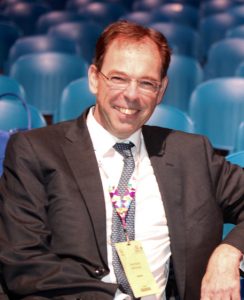
It is very exciting and a great honour to take on the role of president of the ESCRS, one of the major societies in the world of ophthalmology. It is the largest in Europe, has the largest number of members and our Congress is probably second in the world in terms of attendees after the American Academy of Ophthalmology. That shows the enormous impact of the ESCRS on European but also global ophthalmology. We know that people really want to attend our meetings because the content is excellent. What is a continuous challenge of course for us to meet, I am happy that I can be part of that decision machine that tries to put these meetings together as best we can.
My career at the ESCRS began when Gabriel van Rij, who was at that time the chair of the Netherlands IntraOcular Implant Society (NIOIC), proposed me to be a co-opted member on the board of the organisation. Then I was elected board member and over the years I have been active in various committees within the ESCRS. Peter Barry mentored me and made me enthusiastic for the position of treasurer, a role that was assigned to me by the board for almost eight years.
As a university-based ophthalmologist I have always had a great interest in evidence-based medicine. At our University Eye Clinic in Maastricht we have conducted various randomised clinical trials in the field of cataract and lamellar corneal surgery, eg. comparing toric vs monofocal IOLs and comparing different multifocal IOLs and DMEK vs UT-DSAEK.
The funding and organisation of landmark research projects addressing important questions, such as the ESCRS endophthalmitis study and the ESCRS PREMED study, has also had an international impact on ophthalmology, crossing the borders of Europe and stimulating discussion and changing practice patterns around the globe. There is an emphasis nowadays on evidence- and value-based healthcare because we need to determine how can we add value to our treatments in a cost-effective way. During my presidency we will certainly enhance our efforts in sponsoring research projects that can really give us good answers to the questions that we still have.
For the next two years, starting under my presidency, we will put a working group together to establish ESCRS guidelines for cataract and refractive surgery. This is one of the goals that came out of the strategic review that Béatrice Cochener-Lamard initiated during her presidency, asking all the committees what they believe should have the attention of the society over the coming years. Using ideas from this review and evidence from landmark studies we will close the loop and have implementation of our scientific work in the ESCRS guidelines.
We will also put more emphasis on the digital era. We will establish a new committee in the ESCRS, a digital health committee, which will carry out an inventory of the ideas in our membership to apply digital innovations and artificial intelligence to our existing questionnaires and registries.
Another project we are working on will involve collaboration with the American Academy of Ophthalmology, who are currently developing a presbyopia-correcting IOL patient-reported outcomes questionnaire. We would like to adapt that and make it suitable for different European countries and languages. In this way we will create an instrument that can be used to make the interpretation of the outcomes of these studies on a global scale much more uniform. I foresee that this may have significant impact on the development of new devices on the regulatory processes related to bringing innovations to the market.
We are continuously trying to improve our meetings and we are very keen to have the younger membership of our Society more involved to connect them to our meeting. It becomes exceedingly difficult to have a free paper accepted or posted because we have so many submissions and not everybody has access to good research facilities. At our most recent Meetings, particularly our Congress in Paris, we have been using a tracking system to see what our members are doing, how much time attendees spend at the meeting and their preferred symposia. We will be using this information to gradually change how we organise our sessions. One thing we have certainly seen is that people are interested in interactive sessions, where the audience can have some input, as well as integrated panel discussions. Therefore, for the next Amsterdam meeting we will have sessions in which especially young people, can present a case report and we can discuss it. In this way trying to keep the day-to-day connection with what we are doing in practice – the patient sits in front of you and they have a problem and you have to solve it.
So on the one hand ESCRS wants to put efforts into large landmark studies, and on the other I think as a Society our goal is to connect people and educate and assist them in their day-to-day medical decision making.
Rudy MMA Nuijts MD, PhD, is Professor of Ophthalmology, Vice-Chairman, and Director of the Cornea Clinic and the Center for Refractive Surgery at the University Eye Clinic Maastricht, Maastricht Medical University , The Netherlands
From an interview with EuroTimes Contributing Editor Roibeard Ó hÉineacháin

